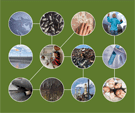Keeping Track, Promoting Health
Download as PDF [477 Kb]
Executive Summary
 In 2000, the Pew Environmental Health Commission detailed an “environmental health gap,” a lack of basic information needed to document links between environmental hazards and chronic disease. The most common environmental health hazards are air and water pollution; asthma, cancer, and lead poisoning are the most frequent adverse health effects that concern Americans.
In 2000, the Pew Environmental Health Commission detailed an “environmental health gap,” a lack of basic information needed to document links between environmental hazards and chronic disease. The most common environmental health hazards are air and water pollution; asthma, cancer, and lead poisoning are the most frequent adverse health effects that concern Americans.
Without a tracking program, environmental causes of chronic diseases are hard to identify. Systematically measuring amounts of hazardous substances our environment, tracing their geographic spread, seeing how they show up in human tissues, and understanding how they may cause illness would seem a wise precaution.
The National Environmental Public Health Tracking Program, developed by the Centers for Disease Control and Prevention (CDC), is the start of that system.
Over the last four years, CDC has laid the foundation of a national system to track environmental hazards and the diseases they cause, updating traditional medical detective work with computers, satellites, and geographic information systems.
The building blocks of that foundation included grants to state and local health departments. Health departments are often best placed to monitor hazards because they understand special local conditions that modify general environmental health risks. In addition to its pilot grants, CDC has collaborated with a number of other federal agencies, professional organizations, and civic groups to mobilize support for the Tracking Program.
The pilot programs and collaborations are not mere exercises, though. They have already begun to pay off in faster responses to environmental health questions and in action to prevent disease.
However, a full-fledged tracking program must do more than simply gather facts. It must connect data sources, provide the tools to make sense of them, and make that crucial information available to those who need it. To do just that, CDC has been working intensely for the past several years to develop the National Environmental Public Health Tracking Network.
The Network, which will promote information system standards to integrate local, state, and national databases of environmental hazards, environmental exposures, and health effects, will be a crucial component of the National Environmental Public Health Tracking Program.
With the help of the National Environmental Public Health Tracking Network, scientists, communities, policymakers, and the public soon will have access to the information they need to make good decisions about preventing disease, keeping the American public healthy, and saving lives.
- Page last reviewed: January 3, 2014
- Page last updated: July 13, 2009
- Content source:


 ShareCompartir
ShareCompartir